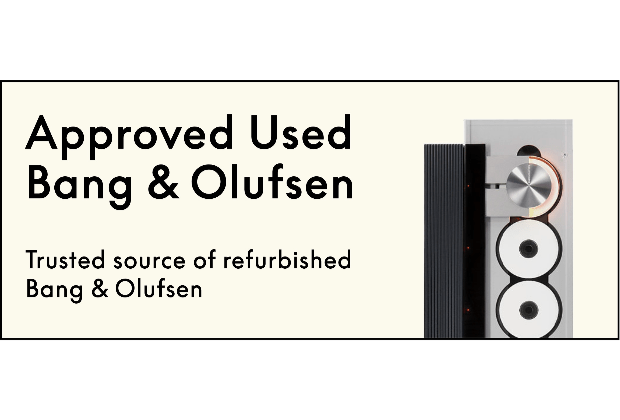Home › Forums › Product Discussion & Questions › BeoSound › New Wireless Speaker Beosound A5?
- This topic has 139 replies, 35 voices, and was last updated 1 year, 9 months ago by
mcatterall10@hotmail.com.
-
AuthorPosts
-
1 May 2023 at 01:12 #45443
matteventu
BRONZE MemberOK, thanks. I was hoping that I could use a better DAC that’s in my pc.. That’s why I bought a Audioquest Dragonfly so I could use that instead my pc as an Roon endpoint. (when listening with headphones f.e) Really hope that BO could be a Roon Ready product soon.. I then have to reconsider what I should do with the A5, sadly as it really is a good speaker with nice punch.
Just to be clear, even without using the Dragonfly, you still wouldn’t be using the DAC of the computer or the DAC of the iPhone.
Putting the Dragonfly in the middle (computer/iPhone -> Dragonfly DAC -> Beosound A5) would be completely useless and actually a bad practice, as you’d run the sound through two DACs. The Dragonfly and the internal DAC of the A5. It’s good practice to do the digital-to-analogue conversion (i.e. what’s done by the DAC) as few times as possible (ideally, just one), so the perfect and most “high quality” way to listen to music on the A5 would be to use only its internal DAC.
How do you ensure you’re only using the speaker’s own DAC? By ensuring that everything you feed into the speaker is pure digital and has never been converted to analogue. And how do you do that? Just by connecting the speaker to the source in the most direct way possible, that is by using digital audio over USB-C.
An external DAC such as the Dragonfly makes sense only if what comes after it is a purely analogue audio device (i.e. passive wired headphones, or an analogue amplifier connected to some speakers – or to headphones).
Placing a digital audio device at the output end of another DAC? Very very very bad choice 🙂
So, just use a Lighting to USB-C cable (I think a normal Lightning to USB-C wouldn’t work as Apple made them only capable of signaling the iPhone to a host device, while in this case the iPhone itself would be the host device, so you either need a Lighting to USB-A camera connection kit and then a USB-A to USB-C cable connected from the camera connection kit to the USB-C input of the speaker, OR a Lightning to USB-C cable specifically made for this purpose – as I think as I mentioned earlier a standard one wouldn’t work).
If you want to use a computer instead, just use a standard USB-A/USB-C to USB-C cable and that’s it.
No need to worry about the Dragonfly, for the best sound out of a Beosound speaker you won’t use it.
Hope it’s clearer now ?
Edit: for iPhone, a Lightning to USB-C OTG cable should work (bear in mind they’re not “Made for iPhone” certified as Apple really wants to sell you the camera connection kit), such as FiiO LT-LT1 or LT-LT3 (different length).
1 May 2023 at 09:33 #45444The problem is….that you on the A5 only have 1 USB-C port.
As long as the battery is full, you – theoretically – can use this for feeding audio (has to be tested, though).
But having to swap cables to charge * in the midst of an album, would be a no go for me.
(I am not aware of a solution/dongle that could charge the battery and pass audio through at the same time).The A5 was made for wireless feeding of audio.
Imo there is nothing wrong with that……unless you absolutely want to connect a turntable (or an older Beosystem ?)*Would be interesting to know, if connecting to a computer also includes charging?
MM
Location: Flensborg————Danmark
1 May 2023 at 11:17 #45445Hi MM,
The A5 does not allow feeding analogue audio into the USB-C port. However, it can connect to a computer using a USB-C cable and thhis will play the computer audio to the speaker, as well as charging the speaker.
Kind regards, Steve.
Location: The cable workshop, England
Favourite Product: Beosystem 72-23
Signature: Cables, friendly advice and great ideas for connecting Bang & Olufsen! Ask any questions at https://soundsheavenly.com to get the best from your B&O! Please visit my B&O YouTube channel at https://www.youtube.com/soundsheavenlycables
My B&O Icons:
1 May 2023 at 11:21 #45446NQVHNWI
BRONZE MemberOK, thanks. I was hoping that I could use a better DAC that’s in my pc.. That’s why I bought a Audioquest Dragonfly so I could use that instead my pc as an Roon endpoint. (when listening with headphones f.e) Really hope that BO could be a Roon Ready product soon.. I then have to reconsider what I should do with the A5, sadly as it really is a good speaker with nice punch.
Normann,
With all due respect to you and your equipment selection is that there is a need to buy into a “system”. I think it is unreasonable that some OEM produces a quality entry-level product with all the standards, connections, superior DAC and Beolab90 quality loudspeakers.
The A5 is targeted a relatively simple (but sophisticated) User who requires to connect a simple music source (say a mobile phone with any given App, or attach to a system with DNLA compliant broadcast) to a useful semi-portable soundbox.
Roon does not support DNLA. Nor does BlueSound. As for AQ Dragonfly – Im sure they are good but their intent is really for filtering noisy PC output or mobile phone outputs to headphones.
I think as per MMs post, if you want to play the game of comparing external DACs to the one inside the A5, go ahead but I dont really think you will achieve anything. Ditto bitrates.
As for USB-C connections, I believe B&O designed the connect for powering the A5 rather than adding on countless peripherals. If that is something you require….why not buy a USB-C hub from Amazon to compliment the A5?
Im not sure if you can still get this – I only remember it vaguely but iFi did once do a Roon to DNLA bridge. (iFi Bridge). Failing that, the iFi Stream may also help.
1 May 2023 at 12:43 #45447Hi MM, The A5 does not allow feeding analogue audio into the USB-C port. However, it can connect to a computer using a USB-C cable and thhis will play the computer audio to the speaker, as well as charging the speaker. Kind regards, Steve.
Hi Steve
Thanks for clarifying.
MM
Location: Flensborg————Danmark
1 May 2023 at 14:26 #45448John
BRONZE MemberI ordered the dark oak today!! Cannot wait!! I also own the Level so it will be interesting to compare them.
1 May 2023 at 16:47 #45449Steph
BRONZE MemberHas anyone been able to compare the sound of the A5 with the sound of the Level?
That would be an interesting comparison…1 May 2023 at 19:35 #45450Has anyone been able to compare the sound of the A5 with the sound of the Level? That would be an interesting comparison…
https://www.youtube.com/watch?v=NsYOOKISiKk
Level sounds better, A5 has more bass.
Location: Toronto, Canada
1 May 2023 at 20:07 #45451Steph
BRONZE MemberThanks ??
2 May 2023 at 00:10 #45452Mark
BRONZE MemberWhat would really be interesting for me, in the future when the Theatre will work with Mozart speakers, is to use 2 A5’s as additional temporary surround speakers. The battery would allow for placement where a power outlet is not available.
2 May 2023 at 06:19 #45453Sia43
BRONZE MemberSteve, would this mean that I could theoretically get signal from a source such as Beosound Essence MK2 as well as the power to the A5 (through USB-C) by connecting the Essence using a CAT-7 cable and USB-C power adaptor while combining them with one of these converters?
2 May 2023 at 07:19 #45454Normann
BRONZE MemberOK, thanks. I was hoping that I could use a better DAC that’s in my pc.. That’s why I bought a Audioquest Dragonfly so I could use that instead my pc as an Roon endpoint. (when listening with headphones f.e) Really hope that BO could be a Roon Ready product soon.. I then have to reconsider what I should do with the A5, sadly as it really is a good speaker with nice punch.
Just to be clear, even without using the Dragonfly, you still wouldn’t be using the DAC of the computer or the DAC of the iPhone. Putting the Dragonfly in the middle (computer/iPhone -> Dragonfly DAC -> Beosound A5) would be completely useless and actually a bad practice, as you’d run the sound through two DACs. The Dragonfly and the internal DAC of the A5. It’s good practice to do the digital-to-analogue conversion (i.e. what’s done by the DAC) as few times as possible (ideally, just one), so the perfect and most “high quality” way to listen to music on the A5 would be to use only its internal DAC. How do you ensure you’re only using the speaker’s own DAC? By ensuring that everything you feed into the speaker is pure digital and has never been converted to analogue. And how do you do that? Just by connecting the speaker to the source in the most direct way possible, that is by using digital audio over USB-C. An external DAC such as the Dragonfly makes sense only if what comes after it is a purely analogue audio device (i.e. passive wired headphones, or an analogue amplifier connected to some speakers – or to headphones). Placing a digital audio device at the output end of another DAC? Very very very bad choice ? So, just use a Lighting to USB-C cable (I think a normal Lightning to USB-C wouldn’t work as Apple made them only capable of signaling the iPhone to a host device, while in this case the iPhone itself would be the host device, so you either need a Lighting to USB-A camera connection kit and then a USB-A to USB-C cable connected from the camera connection kit to the USB-C input of the speaker, OR a Lightning to USB-C cable specifically made for this purpose – as I think as I mentioned earlier a standard one wouldn’t work). If you want to use a computer instead, just use a standard USB-A/USB-C to USB-C cable and that’s it. No need to worry about the Dragonfly, for the best sound out of a Beosound speaker you won’t use it. Hope it’s clearer now ? Edit: for iPhone, a Lightning to USB-C OTG cable should work (bear in mind they’re not “Made for iPhone” certified as Apple really wants to sell you the camera connection kit), such as FiiO LT-LT1 or LT-LT3 (different length).
Hi. Thanks for clarifying this.. I’m not that into the use of dac’s or wiring world (as I maybe should have ).
One thing that’s important for me when I buy a BO product is to let it potential out, and get the best out of the product.
So thanks for clarifying for me about the connectivity.
As the speakers it self, I must say I am really impressed the way it sounds.. It’s really clear and the bass goes deep for it size.
So after using it for the weekend, using Roon and Google cast, I am going to stay with it.. (Still hope that BO would be a Roon Ready product)
And,.. my wife love’s it already.. You all know happy wife, happy life 🙂
2 May 2023 at 07:20 #45455Hi Sia43,
No, that won’t work. The only way to get power and audio to the A5 via USB is to connect a PC. However, any music source (eg. Essence or Core) on the B&O app should be accessible wirelessly to the A5, as is the case for any other Mozart-based speakers.
Kind regards, Steve.
Location: The cable workshop, England
Favourite Product: Beosystem 72-23
Signature: Cables, friendly advice and great ideas for connecting Bang & Olufsen! Ask any questions at https://soundsheavenly.com to get the best from your B&O! Please visit my B&O YouTube channel at https://www.youtube.com/soundsheavenlycables
My B&O Icons:
2 May 2023 at 08:35 #45456What would really be interesting for me, in the future when the Theatre will work with Mozart speakers, is to use 2 A5’s as additional temporary surround speakers. The battery would allow for placement where a power outlet is not available.
It would be cool to be able to snap one from the tv setup for listening in the garden (BT or Wifi) and be sure that it would know it’s role as a surround speaker, once it is back again ?
MM
Location: Flensborg————Danmark
2 May 2023 at 12:58 #45457Sia43
BRONZE MemberThis is a repetition
2 May 2023 at 13:02 #45458Sia43
BRONZE MemberSteve, thanks for your quick response. It is, however, strange that the USB-C connector on A5 only accepts PC signals. Does this mean B&O products will not accept cables to connect in future? If this is the case, the Network link and related products will become obsolete.
2 May 2023 at 13:29 #45459cds
BRONZE MemberThe power supply concerns me a little – the output is rated at a combined 280W RMS and yet it appears that the USB-C module can only handle 45W. This was apparently an issue with the Beolit 17 (and I’m assuming the 20, too), whereby the battery would actually drain at high volume levels while the unit is connected to a charger – the result being that speaker goes into low-power mode and reduces volume considerably. The Beolit is “only” 70W RMS, so the gap between input and potential output is even greater with the A5.
I know it’s unlikely the unit would output a sustained 280W, but the 45W threshold is quite low in comparison. That said, the battery is larger on this than the Beolit so perhaps it’s enough of a buffer that the problem rarely presents itself. I’m interested to hear about real-world use.
2 May 2023 at 16:35 #45460NQVHNWI
BRONZE MemberThe power supply concerns me a little – the output is rated at a combined 280W RMS and yet it appears that the USB-C module can only handle 45W. This was apparently an issue with the Beolit 17 (and I’m assuming the 20, too), whereby the battery would actually drain at high volume levels while the unit is connected to a charger – the result being that speaker goes into low-power mode and reduces volume considerably. The Beolit is “only” 70W RMS, so the gap between input and potential output is even greater with the A5. I know it’s unlikely the unit would output a sustained 280W, but the 45W threshold is quite low in comparison. That said, the battery is larger on this than the Beolit so perhaps it’s enough of a buffer that the problem rarely presents itself. I’m interested to hear about real-world use.
I think we are over-thinking the specs and assuming B&O have not been doing their own Electrical Engineering?
Im sure the A5 can play pretty loud all day connected to the designed power source. Im sure they specify a playback volume and battery life hours as a pseudo metric. Where and how the watts are applied makes a difference and Im too lazy to work out the sound pressure to convert to a watts output.
Think of the BL90. 8200 Watts of digital amplification per speaker. It only does goes this high at full chat for a brief moment in time. If it were sustained, it would melt the power sockets and plugs, electrical power cord etc… Rather, the onboard power supply has an input power, and output power and a degree of integral electrical storage (either the power modules or capacitors etc..) to ride out the loud passages of high music output.
I would relax, go and listen to it, decide if it suits your usage needs or not and buy/dont buy. But I would not for one minute think that B&O don’t know what they are doing power-management wise.
2 May 2023 at 17:04 #45461But I would not for one minute think that B&O don’t know what they are doing power-management wise.
My A2 was rated at 24 hours playback and always lasted under 2 hours. My Halo remote does nothing all day and last 48 hours. My Beoremote 1 is hardly used and the battery lasts a month. I absolutely think B&O doesn’t know what they are doing power management wise.
Location: Toronto, Canada
2 May 2023 at 18:05 #45462NQVHNWI
BRONZE MemberAnd…???
My last response was about the electrical engineering design of a product….power in to digital amplification power out.
Batteries are going to vary in terms of power delivery. But further, is there anywhere where in the B&O specs that says the Halo should last +48hrs? It may be fully on, communicating with something (or trying to communicate with something) and uses just as much power sitting alone as it does with User interaction?
Is this perceived lack of battery life down to the electrical engineering design – or the realisation of poor software (i.e. I hear the Theatre will be receiving an update shortly which will stop it continually chattering with BeoRemotes – to improve battery life).
I think the two issues are separate and distinct. One should not (I believe) worry about the Power Supply delivery on the A5 with listed Sonic power output power of the A5. They are different numbers, derived from different methodologies/applications.
Finally, if the A2 only gave 2hrs playback and nowhere near 24hrs, I would return it as a dud.
-
AuthorPosts
- You must be logged in to reply to this topic.
































